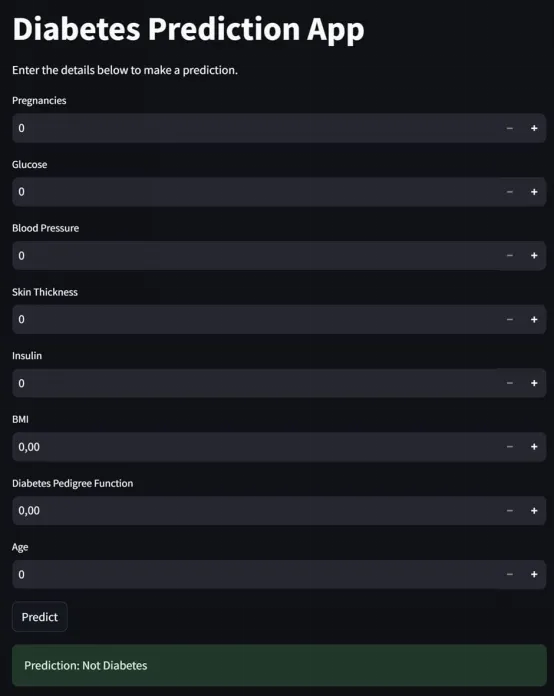译者 | 布加迪
审校 | 重楼
开发机器学习模型只完成了一半工作。除非部署到生产环境、提供业务价值,否则模型仍然毫无用处。

知道如何部署自己的模型已成为任何数据科学家的一项基本技能,许多雇主已经要求我们能做到这一点。因此,对于任何级别的数据科学家来说,学习如何将模型部署到生产环境大有助益。
本文探讨如何将机器学习模型部署到生产环境中。
机器学习模型准备
首先,准备好部署到生产环境中的模型。我们先为整个教程设置虚拟环境。你可以通过在终端中使用以下代码来实现这一点。
复制python -m venv myvirtualenv
在安装并激活虚拟环境之后,你需要安装所需的软件包。创建requirements.txt文件,并用下面的库列表填充它。
复制pandas scikit-learn fastapi pydantic uvicorn streamlit
在requirements.txt准备就绪之后,我们必须使用以下代码来安装它们。
复制pip install -r requirements.txt
一切准备就绪,我们将开始开发机器学习模型。在本教程中,我们将使用来自Kaggle的糖尿病数据。把数据放在数据文件夹中。
然后,在app文件夹中创建一个名为train_model.py的文件。在train_model.py中,我们将使用下面的代码训练机器学习模型。
复制import pandas as pd
import joblib
from sklearn.linear_model import LogisticRegression
data = pd.read_csv("data\\diabetes.csv")
X = data.drop('Outcome', axis =1)
y = data['Outcome']
model = LogisticRegression()
model.fit(X, y)
joblib.dump(model, 'models\\logreg_model.joblib')你可以根据自己的喜好更改数据集的位置和模型路径。我将把模型放入到模型的文件夹中。
我们将跳过所有的数据准备和模型评估,因为本文的目的是将模型部署到生产环境中。当模型准备就绪后,我们将准备部署模型了。
模型部署
在本节中,我们将为模型预测创建API,并使用Docker部署它们,同时使用Streamlit前端测试它们。
首先,确保你已经安装了Docker桌面,我们将在本地测试它。
接下来,在app文件夹中创建一个名为main.py的文件,并用以下代码填充该文件以生成API。
复制from fastapi import FastAPI
from pydantic import BaseModel
import joblib
import pandas as pd
# Load the logistic regression model
model = joblib.load('../models/logreg_model.joblib')
# Define the input data model
class DiabetesData(BaseModel):
Pregnancies: int
Glucose: int
BloodPressure: int
SkinThickness: int
Insulin: int
BMI: float
DiabetesPedigreeFunction: float
Age: int
app = FastAPI()
# Define prediction endpoint
@app.post("/predict")
def predict(data: DiabetesData):
input_data = {
'Pregnancies': [data.Pregnancies],
'Glucose': [data.Glucose],
'BloodPressure': [data.BloodPressure],
'SkinThickness': [data.SkinThickness],
'Insulin': [data.Insulin],
'BMI': [data.BMI],
'DiabetesPedigreeFunction': [data.DiabetesPedigreeFunction],
'Age': [data.Age]
}
input_df = pd.DataFrame(input_data)
# Make a prediction
prediction = model.predict(input_df)
result = "Diabetes" if prediction[0] == 1 else "Not Diabetes"
return {"prediction": result}此外,我们会有一个前端web来试一试我们部署的API模型。为此,在app文件夹中创建一个名为frontend.py的文件。然后,用以下代码填充它们。
复制import streamlit as st
import requests
import json
API_URL = "http://localhost:8000/predict"
st.title("Diabetes Prediction App")
st.write("Enter the details below to make a prediction.")
pregnancies = st.number_input("Pregnancies", min_value=0, step=1)
glucose = st.number_input("Glucose", min_value=0, step=1)
blood_pressure = st.number_input("Blood Pressure", min_value=0, step=1)
skin_thickness = st.number_input("Skin Thickness", min_value=0, step=1)
insulin = st.number_input("Insulin", min_value=0, step=1)
bmi = st.number_input("BMI", min_value=0.0, step=0.1)
diabetes_pedigree_function = st.number_input("Diabetes Pedigree Function", min_value=0.0, step=0.1)
age = st.number_input("Age", min_value=0, step=1)
if st.button("Predict"):
input_data = {
"Pregnancies": pregnancies,
"Glucose": glucose,
"BloodPressure": blood_pressure,
"SkinThickness": skin_thickness,
"Insulin": insulin,
"BMI": bmi,
"DiabetesPedigreeFunction": diabetes_pedigree_function,
"Age": age
}
response = requests.post(API_URL, data=json.dumps(input_data), headers={"Content-Type": "application/json"})
if response.status_code == 200:
prediction = response.json().get("prediction", "No prediction")
st.success(f"Prediction: {prediction}")
else:
st.error("Error in making prediction. Please check your input data and try again.")当一切准备就绪后,我们将创建Docker文件作为模型部署的基础。你应该在文件中填写下面的代码。
复制FROM python:3.9-slim WORKDIR /app COPY app /app COPY models /models RUN pip install --no-cache-dir --upgrade pip && \ pip install --no-cache-dir -r requirements.txt EXPOSE 8000 8501 CMD ["sh", "-c", "uvicorn main:app --host 0.0.0.0 --port 8000 & streamlit run frontend.py --server.port=8501 --server.enableCORS=false"]
我们将创建Docker文件已准备就绪的映像,然后通过容器部署模型。为此,在终端中运行以下代码来构建映像。
复制docker build -t diabetes-prediction-app .
上面的代码为我们的模型容器创建了Docker映像。然后,我们将使用以下代码为模型部署制作API。
复制docker run -d -p 8000:8000 -p 8501:8501 --name diabetes-prediction-container diabetes-prediction-app
一切准备就绪后,确保容器运行并使用下面的地址来访问前端。
http://localhost:8501/
你应该会看到如下图所示的前端。

如果一切顺利,恭喜你!你刚刚将机器学习模型部署到了生产环境中。
结论
在本文中,我们介绍了使用FastAPI和Docker将模型部署到生产环境中的简单方法。
当然,从维护模型和监测生产环境中模型的过程中,仍然有很多东西需要学习。但愿本文对你有所帮助!
原文标题:A Guide to Deploying Machine Learning Models to Production,作者:Cornellius Yudha Wijaya



